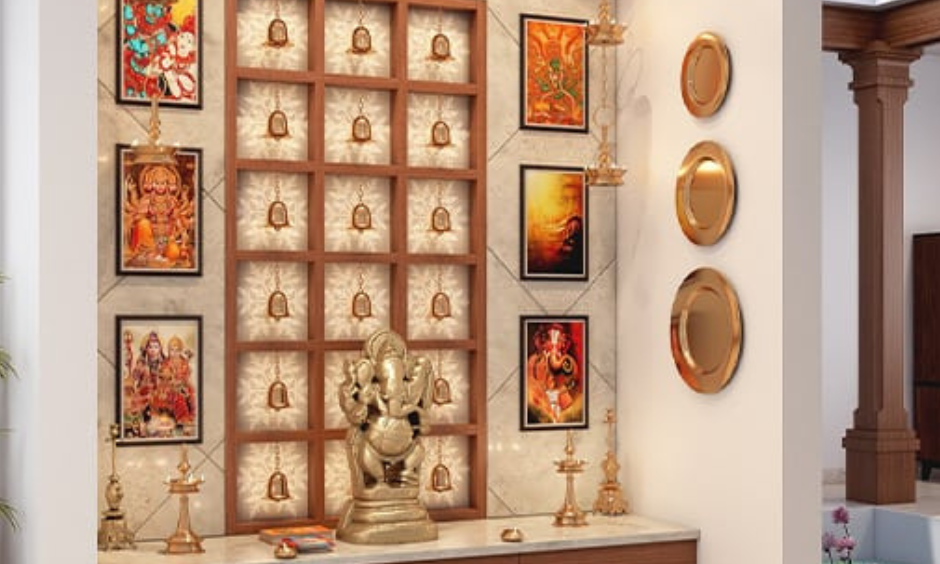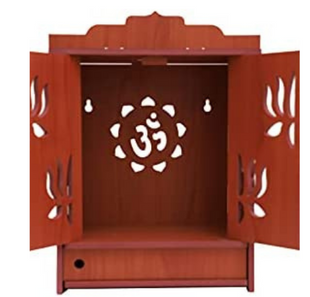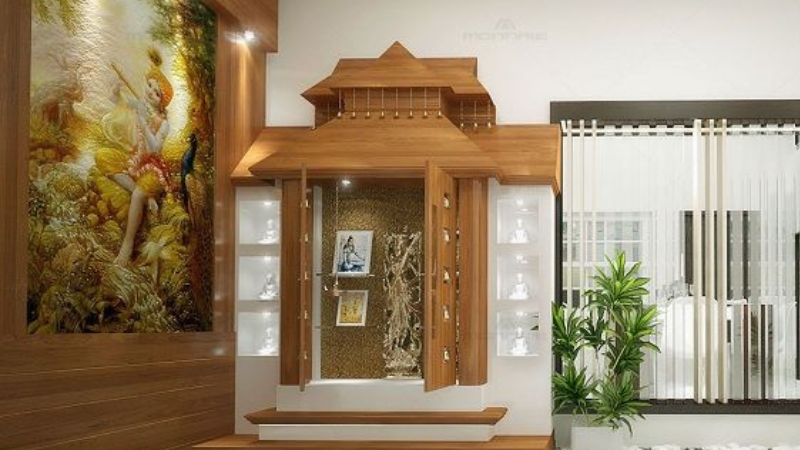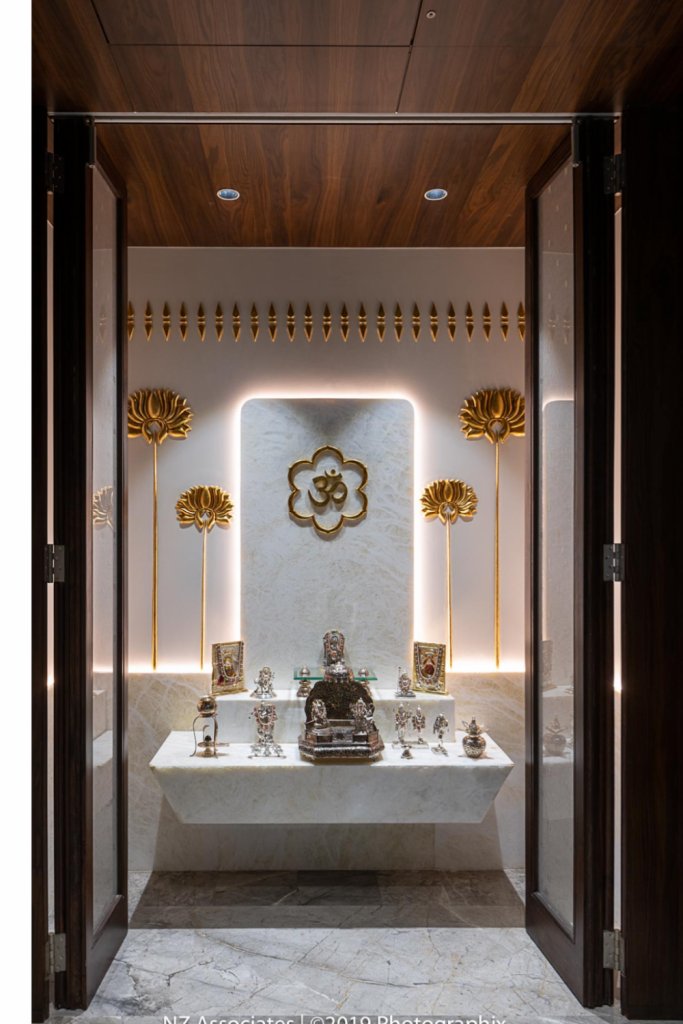A puja room, or mandir, is a sacred sanctuary in a Hindu home where daily rituals and prayers are performed. It is a spiritual haven, a place to commune with the divine and connect with one’s faith on a deeper level.
It is an oasis of serenity and tranquility, a place of peace and positive energy, where the mind, body, and soul come together to seek blessings and guidance. The creation of a puja room is a sacred undertaking, one that requires careful consideration of its placement, design, and contents.
A well-crafted puja room is a powerful place that can help to bring prosperity, success, and spiritual growth to a household. This article will delve into the importance of a Puja Room and different styles of Puja rooms in Indian homes. Let’s explore some amazing Puja Room design ideas and how they can elevate your spiritual practice. But first, let’s understand the importance of a puja room in an Indian household.
Importance of a Puja Room in an Indian Home
A puja room, also known as a puja room or prayer room, is an important feature in many Indian homes. This dedicated space is used for performing Hindu religious rituals and ceremonies and is considered to be a sacred space where the divine and the devotee can connect.
Here are a few reasons why a puja room is important in an Indian house:
- Religious significance: A puja room is a space for spiritual practices and worship. It allows for the daily performance of puja and other religious ceremonies and is considered to be a sacred space where the mind and spirit can be at peace.
- Cultural significance: In India, having a puja room is a traditional and cultural practice that has been passed down through generations. It is considered to be an important part of Hindu home culture and is a symbol of the family’s religious beliefs and practices.
- Promotes unity and togetherness: A puja room brings families together and promotes unity. It is a place where family members can come together to perform puja and other religious rituals, creating a sense of bonding and togetherness within the family.
- Promotes mental and emotional well-being: A puja room can provide a sense of inner peace and calm. The peaceful and serene atmosphere of the room can help to promote mental and emotional well-being and reduce stress.
- Positive energy: It is believed that having a puja room in the house brings positive energy and prosperity to the home. This can be said is a spiritual belief but many people in India believe in it.
Different Styles of Puja Room Designs
1. Traditional Puja Rooms

Traditional style puja room designs in Indian homes are characterized by their intricate carvings and sculptures and are typically made from traditional materials like marble, granite, or wood. They are often inspired by ancient temple architecture and feature detailed and intricate artwork.
In a traditional style puja room interior design, the altar, which is the focal point of the room, is typically made of marble or granite and may include a statue or image of a Hindu deity, as well as other puja-related items. The altar is often surrounded by intricate carvings and sculptures and is often decorated with spiritual symbols and motifs. The walls of the room may be adorned with religious paintings or murals.
The traditional style puja room is typically dimly lit and quiet, with the use of natural light and subtle lighting fixtures in order to create a peaceful and serene atmosphere. The room is typically decorated with traditional elements such as a traditional lamp, a flower vase, and a bell.
The traditional house puja room design is considered to be a sacred space and is usually kept clean and uncluttered, and is reserved for spiritual practices and worship. It is an important part of Indian home culture and is a symbol of the family’s religious beliefs and practices.
It’s good to consult with a designer who is well-versed in traditional Indian architecture, to make sure the mandir is authentic, matches your home design style, and suits your specific needs.
2. Puja Units with a Stone-Embossed Wall at the Back

Puja units with a stone-embossed wall at the back are a popular design feature in many Indian homes. This style of puja room interior design typically features a stone-embossed wall as the backdrop for the puja altar. The stone-embossed wall is designed to be both visually striking and functional, providing a beautiful backdrop for the altar and a space to display religious statues and other puja items.
The stone-embossed wall is usually made of natural stone, such as marble or granite. The stone is often carved or engraved with intricate patterns, motifs, and religious symbols that are significant to Hindu culture. The wall may feature images of Hindu deities and is often decorated with lights or candles to create a warm and inviting atmosphere.
The puja altar, which is typically located in front of the stone-embossed wall, is typically made of marble or granite and may include a statue or image of a Hindu deity, as well as other items such as incense, flowers, and puja plates. The altar may be surrounded by intricate carvings and sculptures and is often decorated with spiritual symbols and motifs.
This style of puja unit is functional and decorative and has a modern puja room design, which creates a peaceful and serene atmosphere. The use of natural stone, intricate designs, and religious motifs creates a feeling of reverence and respect and is a perfect way to honor the divine in your home.
3. Wall-Mounted Puja Shelf

Wall-mounted puja shelves, also known as wall-mounted mandirs, are a space-saving and convenient option for a home puja room. These shelves can be easily hung on any wall and are typically made of wood or metal.
A wall-mounted puja shelf typically includes several levels or compartments for storing puja essentials such as statues, incense, flowers, puja plates, and more. The shelf may also include a small area for an oil lamp or a diya.
One of the main advantages of the wall-mounted puja shelf is that it saves floor space, making it perfect for small homes or apartments. It can also be easily moved or repositioned when needed, without the need for renovation or construction.
Wall-mounted puja shelves are often decorated with traditional designs and can be made from various materials such as wood, metal, glass, or even acrylic. Many are also designed to be foldable or expandable.
4. Temple-Style Puja Rooms

Temple-style puja room designs replicate the traditional architecture and design of Indian temples. These rooms are typically larger and more elaborate than a typical puja room and are often built as a separate structure, like a standalone temple.
Temple-style puja room door design is often grand and imposing with large wooden or stone doors and intricate carvings and sculptures. The interiors are typically large and open, with high ceilings and a central altar that is typically surrounded by columns or pillars. The altar may feature a statue of a Hindu deity, as well as other puja-related items.
The walls and floors of the room are often adorned with intricate carvings, paintings, or murals, depicting religious scenes from Hindu mythology. The room is typically lit with natural light, and additional lighting fixtures are often used to create a warm and inviting atmosphere.
Temple-style puja rooms are often designed to be used for large gatherings and ceremonies, such as weddings and religious festivals, as well as for daily puja and other religious rituals. They are typically built to be grand, imposing, and luxurious and are usually found in larger homes or in temples.
Designing a temple-style puja room requires knowledge of traditional Indian temple architecture and design. It’s important to consult with a designer who is well-versed in Hindu mythology, in order to ensure that your home matches the traditional house puja room design and includes all the necessary elements for performing puja and other religious rituals.
5. Puja Room Inside a Cubicle

A puja room inside a cubicle is a space-saving option and a modern puja room design for homes that have limited space but still want to have a dedicated area for performing puja and other religious rituals. A cubicle puja room is a small, enclosed space that is typically built inside a larger room or area of the home.
The cubicle puja room typically features a small altar that is designed to fit within the limited space of the cubicle. This can include a statue or image of a Hindu deity, as well as other puja-related items. The walls of the cubicle are often decorated with religious paintings or murals, and the floor is typically tiled or made of marble.
The cubicle puja room is typically designed to be functional and minimalist, with minimal decor and a focus on functionality. It is typically small and enclosed, which helps to create a quiet and peaceful atmosphere for performing puja and other religious rituals.
This type of puja room can be created in any small area of the house, by enclosing it with a partition or a wall. It is a good option for those who are looking to save space in the home or for those who live in apartments or small houses.
Final Thoughts
In conclusion, a puja room is a sacred space for spiritual practices and worship that allows for the daily performance of puja and other religious ceremonies. There are different styles and designs of puja rooms to match different needs and preferences. These designs range from traditional-style puja rooms with intricate carvings and sculptures, to modern designs with a clean and minimalistic aesthetic.
Puja Room Design FAQs:
1. Where should I place my Puja room?
Traditionally, the puja room is located in a central and prominent position in the home, such as the front or main entrance, so that it can be easily accessed by all members of the household. It is considered to be auspicious if the puja room is located in the northeast corner of the house, which is known as the “Ishan” corner and considered the most auspicious direction for a puja room according to vaastu shastra.
2. What should not be kept in the puja room
In Hindu tradition, there are certain items and substances that are considered inauspicious and should not be kept in a puja room or mandir. Some of these include impure substances such as leftover food, food waste, dirty or soiled items, non-vegetarian items, leather items, electronic devices, and personal items.
3. Is a door necessary for the puja room?
A door is not strictly necessary for a puja room or mandir, but it can be useful in certain situations. Having a door can provide privacy and seclusion for the person performing the prayers and rituals, allowing them to focus on their spiritual practice without interruption or distraction. A great puja room door design can also help keep the energy and vibrations of the puja room separate from the rest of the home, creating a more peaceful and sacred environment for daily prayers and ceremonies.






